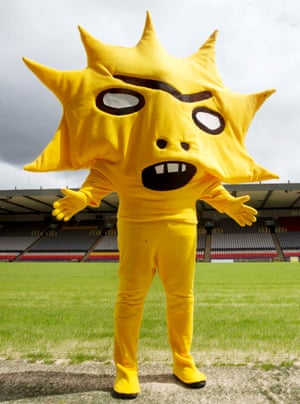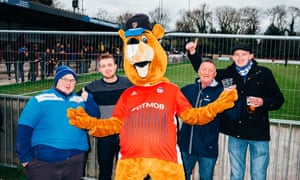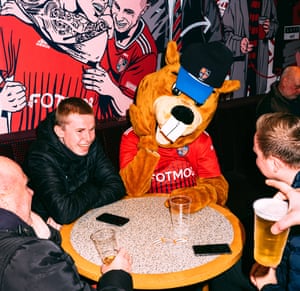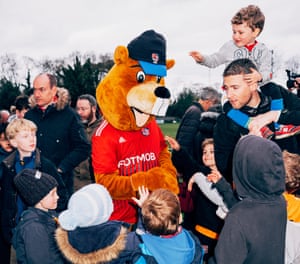[ad_1]
There is no force in the universe more irresistible than a high five from Reading FC’s lion mascot, Kingsley. The only thing that comes close is a hug from Kingsley’s mascot wife, Queensley. Do not ask why a mascot needs a mascot wife, because I cannot explain that in any meaningful way. Mascots intersect society at the exact same angle as cereal box characters: we never question why they are there, what they mean, or why they never blink; but we do demand complicated backstories for them, and extended family trees.
Before all this happened – before the lockdown and the boarded-up pubs, and the groups of no more than two, and the two-metre distancing and the isolation and the ransacked supermarkets, and most crucially the suspension of every single sport on the planet, all at once – I became obsessed with mascots. There they were: jiggling, expressionless monoliths made of felt, pacing up and down the touchline, a seen-but-unseen aspect of modern sport, ever-present and never questioned. In the current void, you could be forgiven for forgetting all about them; but they are just as crucial to the matchday experience as the people kicking the ball, and the other people running after it, as crucial as being one 60,000-throated voice, shouting them all on, as crucial as the pies and the scarves and the long winding walk to the stadium, the urinal queues and the matchday programmes. And there, look: there’s a person in a bumblebee outfit, waving at you. Who are they? What are they for?

On a wet weekend before lockdown, I went walking through the labyrinthine corridors that make up the backstage of Reading’s Madejski Stadium, trying to find out. Kingsley (a lion, who shouldn’t be confused with Kingsley the Partick Thistle mascot, the abstract yellow monster designed by artist David Shrigley) has been a Reading FC fixture since 1997. Kingsley has the dubious honour of being one of the few mascots in sport to receive a red card (for straying too close to the pitch in 2007). But when I visited him, he was behaving himself, warming up the crowd before a vital 3–0 win over Luton. Spirits had been low in previous weeks, with a faltering run of form and a recent managerial change, but mascots cannot sit these periods out: rain or shine, good form or bad, they are pitchside, dancing and pointing.
I stood behind the king and queen, Kingsley and his wife, like a page as they waved at their subjects. I held doors open for them to squeeze through while they smiled at the various birthday parties they had wafted into. I basked in the reflected glory as they shimmied through the pre‑match bar. Everywhere Kingsley and Queensley went, people responded with joy. Children whisper-shouted their names to each other when they spotted their lion eyes glimmering through a door window. Unsmiling, 50-year season ticket holders went mushy as they shook Kingsley’s royal paw.
“You just have to be yourself in there,” Kingsley’s actor, Craig Peters, told me, headless, when we spoke in the staff kitchen an hour before the game. “And I would also say: don’t be afraid to get out of your comfort zone.”
***
It’s hard to say where mascots began, exactly. History is written by the winners, and the winners rarely stop to write, “Oh yeah, bit of a weird one: we took a pig to a football game today. Won. Might do it again, every match, for ever.”
Yes, mascots bring happiness, but who allowed them to happen? They skim into the arena on a zipline. They cover their big unblinking eyes with their hands when an eight-year-old skies a half-time penalty. We accept all this. We look at Manchester United’s cuddly devil mascot, Fred the Red, and think: I’m completely OK with the fact that a demon sent to punish us for our sins is standing on the halfway line right now, having physical banter with Bruno Fernandes.

Baseball, a game riddled with superstition, pioneered the US mascot, though they were mostly just children, rather than adults in animal suits. The first recorded use of the term in sport, in 1883, described a young batboy called “Chic”, who the Pottsville Anthracites considered a good luck charm, as well as being the grunt they got to hand out bats and uniforms to the team. By the late 19th century, the mascot had moved into other sports: Yale’s Handsome Dan (a bulldog belonging to student Andrew Graves) played an essential role in the ceremonial pomp that preceded the college’s American football games.
Live-animal mascots also made their way to Britain. Manchester United, newly minted from the ashes of Newton Heath, replaced Major the St Bernard with Billy the Goat, an animal belonging to half-back Charlie Roberts. Billy was paraded at Old Trafford before games, but his time came to an abrupt end following the 1909 FA Cup final win over Bristol City when, as United Museum curator Jon Sutton writes, “Billy sadly died of alcohol poisoning after taking part in the post-match celebrations.”
I talked to Nick Miller, the author of Dance Like Everybody’s Watching!: The Weird And Wonderful World Of Sporting Mascots, for which he studied mascots from Australia, Japan, the US and the Olympic Games, as well as West Bromwich Albion’s baffling Boiler Man, a combi-boiler with arms and legs, but no eyes. “I don’t really understand why a lot of these mascots can’t just be nice and cuddly, or why they have to go down the nightmare route,” Miller says. “They’re supposed to be for kids, really.”
Mascots graduated from dogs and small children to more haunting cartoon characters with the introduction of the New York Mets’ Mr Met in 1964. The body of a man with the head of a gigantic baseball, Mr Met debuted the year before as a drawing on the front of a matchday programme, but took corporeal form at the opening of the team’s then-new home, Shea Stadium. His pre-match shtick proved popular: by the 1970s he was joined by Mrs Met (becoming, arguably, the first mascot power couple) and then three little Mets – all nameless, all with eerie baseball heads.
Over the next decade, the Mets’ Major League baseball rivals rushed to catch up. In 1974, the San Diego Padres introduced the San Diego Chicken, heralding a frenzied period of invention in the US, climaxing with San Francisco Giants’ Crazy Crab. The crab was designed as a sort of “anti-mascot”, who deliberately got the crowd so riled that they pelted him with beer bottles and batteries (actor Wayne Doba had to wear protective equipment inside his soft outer shell). In 1984, Crazy Crab was tackled by two of the San Diego Padres, leaving Doba incapacitated for the last two games of the season. Crazy Crab was quietly retired in 1985.
Mascots don’t share an overarching aesthetic. They can be fuzzy, furry, hairy or slick; they can be aliens or monsters or animals. But the one recurring theme is that they have someone inside them, most often someone who already works for the team, who has acquired the job because, put simply, they were there. “It was a pre-season game against Bournemouth, actually,” Peters tells me. “My intention was to go and just watch the game.” Peters also works for Reading’s community outreach programmes. “And then my colleague said, ‘What are you doing? Do you want to be Queensley with me?’ So I did it. Then they said they didn’t have a Kingsley for the upcoming season and that’s when I thought, you know what, I enjoyed that.” Peters says he wears “just boxers” when he is Kingsley; there is no protective clothing necessary.
Miller has spoken to more mascots than anyone else alive, and tells me he has noticed a pattern. “You don’t get many careerist mascots. The origin story is always, ‘Oh, you know, the previous guy was ill, or they needed someone, anyone, to prance around in this thing. I was there.’”
That’s not to diminish the role: on a good day, the mascot becomes an extension of the crowd, urging the ball towards the net; on a bad day, they are a focal point for anger, the home crowd’s howling after going 3-0 down. And on a terrible day, they might get into a fight: famously, Swansea’s Cyril the Swan went head-to-head with Millwall’s Zampa the Lion during a heated match in 2001. An honourable mention should also go to Watford’s Harry the Hornet, who mocked Crystal Palace forward Wilfried Zaha during a league clash in 2016. Things can get out of hand.
***

These great chapters in mascot history run through my head as I enter the turnstile to Hampton & Richmond Borough FC’s Beveree stadium. It is the March weekend when the Football League abandons games because of coronavirus, but when the lower leagues are still playing. Without competition from the bigger games, there is a capacity local crowd to watch the team face their Vanarama National League South rivals, Oxford City.
To truly understand the psyche of the person inside the suit, I have agreed to be Hampton & Richmond’s mascot, Bertie the Beaver. I retire to the female officials’ changing room to become Bertie in a shower cubicle. This, I imagine, is much like any complicated, ceremonial dressing routine – buttoning up a suit on the morning of your wedding, pulling a graduation gown over your clothes – in that it slowly transforms you into a different person, with a different demeanour. When I nestle a gut-sized wad of cotton between my thighs and my stomach to give Bertie his signature belly (and, more practically, to stop rowdy children absolutely hammering me in the testicles), I feel nothing. When I clamber into a fleece bodysuit, I feel sturdy and hot. But slowly the picture comes together: I pull two paw-shaped loops over my shoes and Velcro them to my legs, then draw three-fingered gloves over my own hands. I can no longer walk unassisted.
Wearing an XXL-sized Adidas shirt over my enormous new frame, I am in matchday mode. And then, finally, the head: like a huge, padding-lined, low-visibility crown, it is Velcroed to the neck of my bodysuit by my minder, Tanc. I am now eight feet tall. My vision is reduced to a small gauze window hidden in Bertie’s mouth; all audio is fuzzed out by the fleece around my ears. The inside of the head smells of fresh grass and old sweat. I have to heave each leg high off the ground in order to plant it safely in front of me. I am surrounded by cotton and darkness. Bertie the Beaver, like a demon devouring my soul, takes over.
I cannot remember what happened when I was in the suit. There was flossing, I think. There were high fives. A group of children in matching football kits started kicking me up the bum. Throughout, I maintained a stoical silence, making huge CBBC-presenter gestures, hugging all who came near me.

It is interesting to see how crowds react to you when you’re a large, clumsy beaver who can’t get through a doorway properly: frightened children peer from the sides of the stands to play peekaboo; drunk lads sprinkle fag ash on your shoulder as they pose for a completely irony-free selfie; weatherbeaten older blokes, heads down on the way to the bar, gleefully poke you in the belly pad.
Walking off the pitch after I had loomed eerily over the pre-match coin toss, I saw a sullen teenager, sulkily watching from the sidelines, half-peering at his phone. I blasted him with two finger-guns. Nothing. I shook my entire body in a woeful dance. Not a flicker of emotion. Slowly, deliberately, I peeled up to him, my hand extended in a high five. And yes, you know it. I am Beaver, I am fur, I am irresistible. I am Bertie. He smacked my hand and cracked into a smile.
I am mascot, destroyer of sadness. My work out here is done.
• Comments on this piece are premoderated to ensure the discussion remains on the topics raised by the article. Please be aware that there may be a short delay in comments appearing on the site.
[ad_2]
Source link